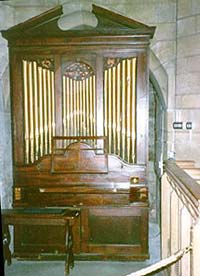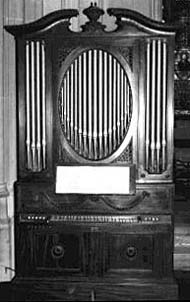David Bridgeman-Sutton thought he was going for an uneventful drive in the Lancashire countryside.
But he didn't reckon on. . .
But he didn't reckon on. . .
SERENDIPITY*
(see postscript)
It didn't seem worth looking for an organ in the little mission church - a hut-church rather than a hall church. A harmonium with mice in it was the very best that could be expected. (A hedgehog once appeared from one in Invercargill, causing much consternation). However, sensible Morecambe mice would be asleep on that typically wet Lancashire afternoon and even looking at a harmonium would make a change from driving.
|
The mahogany case, about the size of a very large book case or wardrobe, its gilded front pipes glowing in the murk was a thrilling as well as an unlikely sight. Above the single manual - black naturals and white sharps - was the name John Snetzler ~ that of one of the several great German builders who settled in England in the 17th and 18th-centuries. (In recent years, it has been claimed that he was Swiss.) His work included a considerable number of chamber organs, similar to this, as well as larger church instruments, several of which were made for the American colonies and their successor, the USA. He invented the dulciana stop.
Of the two Snetzler small instruments illustrated here, fallible memory suggests that in general appearance it more closely resembled that at Eton College. Unlike much of his work, this was in original condition. Errors and omissions excepted ~ this was 35 years ago ~ the stop-list was: |
Several of the stops beside the sesquialtera/cornet drew in halves, with the break occurring at middle c. The hautboy was in a swell box in which the shutter rumbled up and down like a sash window. It was a versatile instrument intended to delight a drawing room in Hanoverian England. How on earth it had come to such an unlikely place?
When the church was first proposed, two ladies living in the parish announced that they intended to present it with an organ they had in their house. General expectation was that it would be a harmonium The Snetzler thus started on its 50-year career of astonishing people just by its presence .
The ladies' father, or perhaps grandfather, had bought it from a house where it was no longer wanted and it had been in their home ever since. The belief that it had been built for a Royal residence deserved some credence because king George III had bought more than one instrument from Snetzler. No one really knew its history; it was sold on closure of the church and went to the USA. If any visitor to the site knows more of its origins or of its present whereabouts, please send an e-mail. The attempt to keep it in England is a story, can be read elsewhere (see below).
When the church was first proposed, two ladies living in the parish announced that they intended to present it with an organ they had in their house. General expectation was that it would be a harmonium The Snetzler thus started on its 50-year career of astonishing people just by its presence .
The ladies' father, or perhaps grandfather, had bought it from a house where it was no longer wanted and it had been in their home ever since. The belief that it had been built for a Royal residence deserved some credence because king George III had bought more than one instrument from Snetzler. No one really knew its history; it was sold on closure of the church and went to the USA. If any visitor to the site knows more of its origins or of its present whereabouts, please send an e-mail. The attempt to keep it in England is a story, can be read elsewhere (see below).
If Snetzler were alive today, he would probably be in the used-car trade. When asked by churchwardens what their existing organ would be worth in part-exchange for a new one, he is said to have replied "If you spend a £100 on it, it'll fetch £50."
David Bridgeman-Sutton,
September 2002
September 2002
David writes:
* Postscript (November 2004): Thanks to an enquiry from Graham Bartholemew and research by Althea, it has been established that this organ did not leave its native shores. It is now in the chapel of Clare College, Cambridge. The specification given above credited it with a non-existent open diapason - otherwise, memory served!
* Postscript (November 2004): Thanks to an enquiry from Graham Bartholemew and research by Althea, it has been established that this organ did not leave its native shores. It is now in the chapel of Clare College, Cambridge. The specification given above credited it with a non-existent open diapason - otherwise, memory served!



